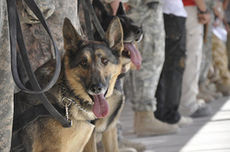Military working dogs are deserving of our gratitude as well on Memorial Day

flickr photo courtesy of the United States Army
The question that I heard more this week than any other — ‘What are you doing this weekend?’ — wasn’t at all surprising. The thought of a whole three days off because of a federal holiday for most people is a welcome one, and of course there are fun events planned — perhaps a getaway that’s just a car drive away — or maybe a little catching up on things around the house.
Of course, we can’t forget that Memorial Day is a time to remember those who died while in our country's service. With the events of the past several years, I think we are all more mindful of the effort and sacrifice by members of our military.
With a traditional image solidified in our minds of those who have served in the military, chances are that we might be missing an important group who gives as selflessly: Military working dogs.
Since World War I, military working dogs have been in use, and, during the Vietnam War, the use of military working dogs increased. German Shepherds were usually the breed of choice, along with Labrador Retrievers. Capacities that the dogs (and their handlers) served in were usually as scout dogs, combat tracker teams and mine tunnel dog teams.
In saving countless lives, those canines have also become casualties.
So, why use dogs in this capacity? It’s simple.
Dogs are amazing creatures and have abilities that are unmatched by even the most well-trained human soldier. In some cases, without their "expertise," so to speak, some of the strides that are made wouldn't be possible.
In fact, former commander of United States forces in Afghanistan, Gen. David H. Petraeus had noted in 2010 that “...the capability they bring to the fight cannot be replicated by man or machine.”
One of those examples was put in the spotlight last year with a Belgian Malinois named Cairo who accompanied Seal Team Six on the raid that killed Osama Bin Laden.
Military working dogs are resilient both mentally and physically, but they can be affected by traumatic experiences, just like humans. By some estimates, 5 percent of the hundreds of dogs deployed have developed Post Traumatic Stress Disorder, or PTSD, a concept that is still being wrestled with by veterinary professionals specializing in behavior.
So, what capacity do military working dogs serve in? Typically, they’re involved in patrol work and in explosives detection skills. During peacetime, they assist their human counterparts in drug intervention along the United States' southern borders and work as drug detector and explosive detector dogs with the Secret Service.
The irony is that military working dogs serve valiantly alongside people in dangerous situations, but they are not categorized the same as their human counterparts: they are classified as “equipment” by the government.
Legislators are proposing a change to this policy, however. In February 2012, Rep. Walter Jones (R) of North Carolina introduced The Canine Members of the Armed Forces Act to the House, and Sen. Richard Blumenthal (D) of Connecticut did in the Senate.
The legislation would reclassify military dogs as "canine members of the armed forces" instead of "equipment." Additionally, the proposal would establish a recognition system for military working dogs killed in the line of duty and commendable service awards for extraordinary bravery on the part of a military dog.
The pending legislation would also set up a nonprofit organization to provide medical care for retired military animals — something that they already get before retirement.
With each passing year, one thing has become evident: Without the sacrifice of military working dogs, some of the work that is done would be much more difficult or impossible.
On this Memorial Day, let’s remember that these animals have played an important role in our nation’s armed forces — some having paid the ultimate price — and are deserving of our gratitude as well.
Lorrie Shaw leads the pets section for AnnArbor.com. Catch her daily dog walking and pet sitting adventures or email her directly and subscribe to AnnArbor.com's email newsletters.


Comments
Sarah Rigg
Mon, May 28, 2012 : 11:49 a.m.
I don't like either solution. Calling a living being "equipment" is extremely distasteful to me, but "canine members" of the armed forces is kind of over-the-top the other way.
Katherine Wilburn
Mon, May 28, 2012 : 7:17 p.m.
Not if you've ever known a military working dog or their handlers. These dogs suffer from physical ailments brought on by combat, even post traumatic stress just like a human does. Ask any handler or anybody who has ever worked with a MWD or SSD dog and you'll hear the same thing. Those are their partners, just as much as another soldier is. They deserve recognition for the work they do, anything less is just not good enough. - A US Army vet and the wife of a MWD Handler.
Local Lady
Sun, May 27, 2012 : 12:43 p.m.
"Soldier Dogs" is a recent book on military dogs. It is well-written, easy to read and an excellent analysis of how dogs are selected, trained and used in today's military. I immediately write my representative to support the bills mentioned in the book and in this article. You should also be aware that military dogs retired overseas are NOT brought back to this country by the military instead they demand that the adopter pay for the transportation. This is wrong and should be stopped. The cost is minimal!